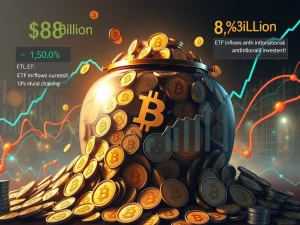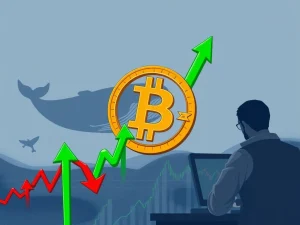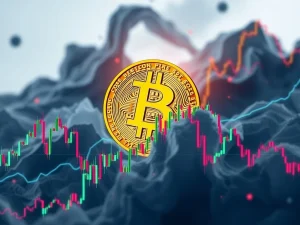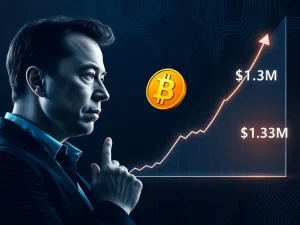Bitcoin Millionaire Myth: The Harsh Reality of a 2010 $1 Investment

The allure of becoming a **Bitcoin millionaire** from a tiny initial purchase is a powerful daydream for many. Imagine traveling back to 2010, investing a mere dollar, and returning to the present day with millions. This scenario, however, is largely a myth. In March 2010, the first recorded Bitcoin (BTC) exchange price hovered around $0.003. Prices never exceeded $0.40 that year. Today, BTC trades well into the six-figure range. The truth is, achieving such wealth required far more than simply buying early. This article delves into why the ‘time-travel millionaire’ fantasy rarely became reality, exploring market volatility, critical events, and the immense discipline needed for any significant **Bitcoin investment**.
The Elusive Bitcoin Millionaire Dream
Many people envision a simple path to wealth: buy low, sell high. For **early Bitcoin adopters**, this journey was anything but simple. The idea of turning $1 into millions seems straightforward on paper. However, this dream overlooks numerous obstacles. Investors needed to build a substantial BTC position. Then, they had to maintain that position through multiple 80% to 90% price crashes. They also faced exchange failures, evolving regulations, the constant risk of losing private keys, and years of temptation to cash out ‘life-changing profits’. This piece examines Bitcoin’s turbulent price history. It also looks at headline-driven shocks, behavioral traps, and the mathematical improbability of this widespread fantasy.
Navigating Extreme Crypto Volatility
Bitcoin’s rise from obscurity to six-figure valuations involved a series of sharp surges and brutal crashes. These events would have prompted most rational individuals to sell their holdings. Consider the following timeline of **crypto volatility**:
- 2010-2011: In January 2010, $1 could purchase approximately 333 BTC at $0.003 each. By June 2011, when Bitcoin peaked at $30, that initial stack was worth almost $10,000. Soon after, the price collapsed. The net value of those 333 BTC then fell to about $666.
- 2013: The same stack soared to roughly $88,000 at the $266 April high. It then plunged to over $16,500 by summer. By November’s $1,000 peak, your initial dollar would be worth $333,000.
- 2014-2015: The Mt. Gox collapse severely impacted market confidence. It sent the price to around $150, reducing your stack’s value to almost $50,000.
- 2017-2018: At approximately $20,000, your initial $1 investment briefly reached $6.66 million. However, by the 2018 low, it fell to about $1.13 million. This was still substantial, but a steep decline.
- 2020-2022: COVID-19’s ‘Black Thursday’ halved Bitcoin’s price in two days. The November 2021 all-time high of $69,000 pushed your stack to $22.98 million. A year later, it slid to $5.29 million.
- 2024-2025: In March 2024, Bitcoin achieved a new all-time high above $73,000. This made your original dollar worth over $24 million.
Surviving all these highs and lows—the euphoria, the crashes, the scandals—presents a final challenge: why sell now? Unrealized gains in Bitcoin resemble quantum superposition; they only ‘collapse’ into reality upon sale. Until then, your millions exist merely as numbers on a screen, vulnerable to Bitcoin’s next move. Andrew Tate famously noted that after roughly $20 million, more money typically doesn’t alter daily life, unless one pursues ultra-luxuries.
Headline Shocks and the Challenge of Holding Bitcoin
Not all selling pressure originated from price drops. Some of Bitcoin’s greatest tests came from news events. These events challenged even the most committed **holding Bitcoin** strategies. For example:
- Exchange Disasters: In 2014, Mt. Gox, then handling over 70% of global Bitcoin trading, announced it had lost more than 650,000 BTC. Its bankruptcy wiped out thousands of early investors. Furthermore, the 2016 Bitfinex hack saw over 119,000 BTC stolen. This understandably fueled fears of more exchange failures. Many similar incidents have occurred.
- Crime and Stigma: The FBI’s 2013 takedown of Silk Road linked Bitcoin to illegal trade in the public mind. Multimillion-dollar wallet seizures resurfaced for years. This fueled debate over whether Bitcoin was inherently tied to criminal activity.
- Policy Shocks: China repeatedly disrupted markets. Its actions ranged from a 2013 banking ban to 2017 exchange closures. In 2021, it declared all crypto transactions illegal. Each event sparked fears of wider crypto regulation crackdowns globally.
- Forks: The 2017 blocksize debate, the Bitcoin Cash fork, and the abrupt SegWit2x cancellation divided the community. These events raised questions about Bitcoin’s long-term scalability and stability.
- Industry Implosions: The 2022 FTX collapse, at the time the second-largest crypto exchange, triggered a widespread liquidity crisis. Mainstream media published numerous ‘crypto is dead’ headlines.
Each of these moments forced investors to reconsider their position. Was **holding Bitcoin** still worth the inherent risks? Even with the foresight to buy Bitcoin early and the discipline to hold through every market crash, scandal, and policy shift, retaining access to your coins was not guaranteed.
Lost Access: A Major Hurdle for Early Bitcoin Adopters
Bitcoin ownership is binary: you either control the private keys, or you don’t. Once lost, your fortune vanishes. Lost coins represent a significant factor. Chainalysis estimates that between 2.3 million and 3.7 million BTC are permanently out of circulation. These coins are locked in wallets with misplaced, destroyed, or otherwise inaccessible keys. Many belonged to **early Bitcoin adopters** who treated Bitcoin as a mere curiosity. They stored it on laptops or external drives that were later wiped, recycled, or discarded.
A famous example is James Howells, an engineer from Newport, Wales. He accidentally discarded a hard drive containing approximately 8,000 BTC, now worth hundreds of millions. He has spent years seeking permission to dig through a landfill to recover it. Even diligent holders were not immune. Coins stored on exchanges that later failed, like Mt. Gox or QuadrigaCX, could disappear overnight. In these cases, ‘hodling’ was no longer a choice; access was simply gone. In Bitcoin’s history, the greater danger often involved losing access completely, rather than selling too soon.
The True Path to a Bitcoin Millionaire Status
History reveals almost no documented cases of the $1-to-Bitcoin-millionaire story by 2025. Instead, the following examples better reflect the actual scenarios:
- Kristoffer Koch: He bought around 5,000 BTC in 2009 for $26.60. He sold 1,000 BTC to purchase an apartment, years before Bitcoin’s largest rallies.
- Stefan Thomas: He lost access to over 7,000 BTC (worth over $400 million today) due to a forgotten password for his IronKey.
- The Winklevoss Twins: They became Bitcoin billionaires after buying approximately 70,000 BTC with an $11 million lump sum in 2013, long after Bitcoin’s sub-$1 days. This was a significant **Bitcoin investment**.
- Li Xiaolai: He accumulated over 100,000 BTC by making large purchases in 2011, not with spare change.
To summarize, significant Bitcoin fortunes were not made by a casual, buy-and-forget strategy with mere pocket money. They resulted from large early stakes, stringent security practices, exceptional discipline, and the rare ability to endure both parabolic rises and severe crashes without panic selling. That is why the ‘time-travel millionaire’ idea remains more myth than reality. The number of people who have lived through Bitcoin’s full price history while still **holding Bitcoin** from an original small stack is vanishingly small.










